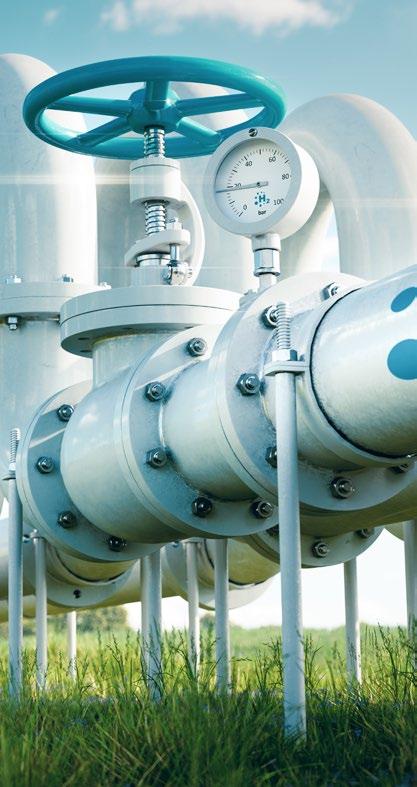
4 minute read
DEVELOPING PETROLEUM PORTS
Under the presidential directives to turn Egypt into a regional oil and gas trading hub, the MoPMR put a plan to develop all the petroleum ports in 2016.
Petroleum Ports Development Projects
Advertisement
The development projects within Alexandria port, Al-Hamra port expansions, Sonker Bunkering company's project at Sokhna port, and Sidi Kerir port witnessed significant progress.
1. Alexandria Port
During February 2021, the MoPMR agreed with the Ministry of Transportation to improve the efficiency of petroleum facilities in Alexandria Port, responding to President El-Sisi’s directives to link sea and dry ports with logistics zones, most importantly the SukhnaAlexandria axis, passing through industrial zones, dry ports, and logistics zones, according to MoPMR press release.
In this context, PETROJET would implement five berths specialized in loading and unloading petroleum products as well as supplying cargoes. The project directly linked the logistics and goods distribution centers to the Alexandria Seaport through an integrated multimodal network to increase circulation in the port and to increase the spaces available for storage services.
Additionally, two logistics zones were agreed to be developed. The
2. Al-Hamra Port Expansions
Al-Hamra has become an alternative destination for the Russian oil exports in light of looming Western sanctions imposed on Moscow.
In July 2022, Russia shipped a cargo of about 700,000 barrels of oil to the Al-Hamra oil terminal, according to Bloomberg. After that the MoPMR has embarked on expansion works at the Al-Hamra petroleum port area in September 2022. The expansions cover an area of 120 acres to enhance the storage capacity of the port facilities. Accordingly, this will add four storage tanks with a capacity of 630,000 barrels of crude
Promoting the Specialized Petroleum Ports
The MoPMR implemented a work program to develop all specialized petroleum ports and enhance their efficiency while taking into account all environmental requirements. The most important developed ports are Sumed, Sonker in Ain Sokhna, Gouna Petroleum Basin in Alexandria port, MIDTAP Pier in Dekheila port, and Al-Hamra in El Alamein.
first logistics zone spans over 273 feddans at EGP 1 billion at the Metras Basin. The second one was developed over 12 feddans in Nagaa Aluminum over 31.9 thousand km2 oil each, to reach a total storage capacity of 5.3 million barrels (mmbbl) to facilitate trade flows and receive crude oil in the port of Al-Hamra, as stated in the MoPMR press release.
As part of the national plan to develop the maritime sector in Egypt, the Ministry of Transportation established a multi-purpose maritime terminal in Alexandria “Tahya Misr” over the last two years. The terminal has been developed with a capacity for over 2 million tons (mmt) of goods a year, which is expected to boost the port’s annual revenues by $50 million, shorten waiting times for ships docking at the port, create investment opportunities, and provide 4,500 direct and indirect job opportunities. The cost of developing and renovating the port amounted to around EGP 60 billion whereas the establishment of the Tahya Misr multipurpose station cost EGP 9 billion.
An additional 420-acre plot of land adjacent to the port will be used for the circulation and distribution of petroleum products and a shipping station to serve the expansions of the Al-Alamein area. These two new expansion areas add an area for the port up to 240% of its current area, according to the MoPMR press release.
3. Sonker Bunkering Company's Project at Sokhna Port
Sonker project aims at constructing and operating a bulk-liquids terminal for the import and storage of diesel and LPG, with an investment cost of $450 million. It was established on an area of 400,000 m2 , at the Port's third basin. Its first phase aims at storing and trading diesel and butane.
4. Sidi Kerir Port Upgrade Project
The project includes the construction of three ultra-cooled storage tanks, with a total capacity of 150,000 m3 to store LPG. It also includes the construction of three storage tanks with a total capacity of 100,000 m3 to store diesel, as well as the construction of two pumping stations for diesel and butane, according to the Egyptian Cabinet.
Ports Capacities Expansion
The development projects that have been implemented had a remarkable impact on the capacities of petroleum ports as they expanded by 70% in FY 2021- September 2022 compared to FY 2014/15.
Fuelling Ships
The MoPMR has made great efforts to make Egypt a center for fuelling ships again. Two of the four licenses have already been handed over to Minerva Bunkering and Peninsula Ports international companies that started their activities in May 2023.
International Cooperation To Develop The Egyptian Petroleum Ports
Hutchison Ports announced on March 16 its investment project, which aims at establishing two new container terminals at Ain Sokhna Port and the Port of Alexandria in Egypt.
Sokhna Port's Project
The project targets developing a new strategic container terminal located on the Red Sea; it will feature modern technology and equipment to provide efficient and reliable services, according to the Hutchison Ports website.
Alexandria Port's Project
This project will develop B100, a new container terminal in the Port, to serve as a new gateway to Alexandria Port, which is one of the largest
2. Cooperation with Belgian Antwerp Port
In January 2022, the MoPMR held talks to enhance cooperation with Antwerp Port in the fields of petroleum port development, logistics
PROJECTS' INVESTMENT VALUE
$700 million
New Terminal
Capacity
1.7 million twenty-foot quivalent units (TEUs)
Boosting Egypt’s maritime trade
O ering Direct access to major shipping routes ports in the Mediterranean and a key hub for trade between Europe, Asia, and Africa, according to Hutchison Ports website. services, and capacity building in 12 petroleum ports at various governorates, according to the MoPMR.
The persistent development of the petroleum ports is considered an integral part of the MoPMR plans to turn Egypt into a regional energy storage and trading hub. Several future projects will be implemented to further expand petroleum seaports, raise its efficiency, and develop its capabilities as a logistical center. Those projects also pave the way for enhanced trade capacities and international investments, enabling Egypt to be a key player in the global maritime industry.









